The Art of Grey Duck Garlic
Can garlic be beautiful, funky and fresh?
Sadly, working with garlic isn't the same as photographing rare botanical species, endangered animals, heirloom farmyard animals or even cute kittens and puppies. People rarely ooh and awe over the beauty of a simple allium bulb. No-one talks about the majesty of a roaming herd of garlic. Allium bulbs rarely gambol across a sunlight field of spring flowers. 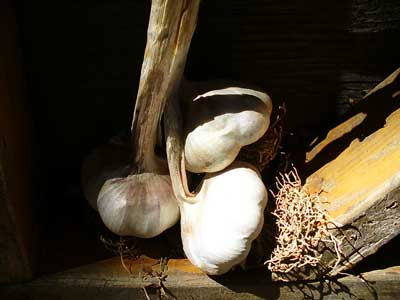
Picture: Still Life with Lorz Italian Garlic Bulbs (not in the Garlic Wing of the Louvre yet).
At Grey Duck Garlic we enjoy expressing our artistic side. Our palette may be limiting but we enjoy the challenge of emphasizing the simple elegance of this humble herb.
Jane and I (Susan) never grew out of coloring with crayons so we create the website artwork. I designed the series of headers and our more official logo of the grey duck carrying a garlic. I like playing with the colors on the website. It is an endless source of frustration to me that no two browsers show colors the same!
I enjoy the interaction between hand drawn artwork, photographs and computer artwork. Basically I believe that art should reflect your fun and creative side and not be taken too seriously. Of course, it is hard to take yourself too serious when almost every picture you draw or photograph contains garlic. It's not like many museums have a Garlic Wing. "A hush comes over the group as they approach Van Gogh's famous painting 'Still Life with Bloaters and Garlic'. As their eyes roam over the oil painting a small voice pips up. "Daddy, that picture is making me hungry!""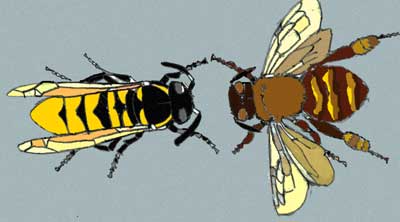
Picture: A rare example of non-garlic art, Bee vs Wasp. We have a new section all about bees which discusses the causes of CCD and how you can help bees.
Five precedences for working with garlic in art:
1) G. Mark Lawrence Libunao, a Philippine man who is painting with garlic oil to create indigenouism art. He makes the garlic oil by frying the garlic in oil. Garlic oil is normally dark brown but turns yellower on the canvas. The garlic 'paint' is layered to create darker colors. Libunao's work features a monochromatic palette with mythological or rural scenes.
Warning for those who wish to try this at home: Libunao had to develop a garlic oil preservative to prevent the oil on his paintings from growing mold.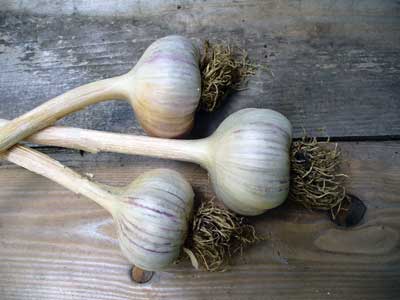
Picture: Garlic on Board: featuring German Mountain garlic bulbs.
2) The artist Christo, who is a healthy and active in his eighties, eats one head of garlic every morning for breakfast. Christo, who is well known for his massively large and eerily beautiful environmental artworks, makes sure to travel with his own garlic supply. Christo and Jean-Claude's large scale art pieces are labours of Hercules, take years to bring to realization and last only weeks. When Christo was asked why he does his temporary art he had this to say. “To do work of art,” Christo said. “Basically they exist because they are totally irrational. They are useless. The use of the project is only for the beauty.”
3) Medieval artists smearing copper panels with garlic to help the paint catch on the smooth surface. Enzymes in garlic help create a tooth or grain in the copper which catches the paint.
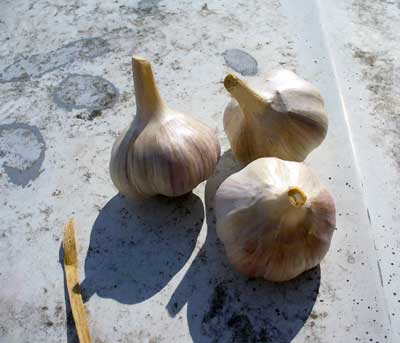 Picture: Concrete and Garlic: done in Romanian Red garlic bulbs. "This starkly modern piece explores the resurgence of garlic growing in urban areas."
Picture: Concrete and Garlic: done in Romanian Red garlic bulbs. "This starkly modern piece explores the resurgence of garlic growing in urban areas."
4) Medieval artist also used a 'mordant of garlic juice' to fix gold, silver and tin leaf on manuscripts, furniture, painting frames, marble, tin or whatever else you happen to have lying around that would look better with a precious metal inlay.
The traditional recipe is as follows: Pound the garlic and pass (strain) resulting juice through a linen cloth. Grind garlic juice with a little white lead. Add sufficient Armenian bole (a clay and glue mixture) to color the garlic juice/lead mixture and enough urine to let you grind all of the mixture well. Once it is the correct consistency, apply the resulting concoction to your work with the pencil. Let mixture dry on work, remoisten it by breathing on it (Susan adds: whatever you do don't lick it, yuck!), lay on the gold and fix with cotton. Although this recipe is of historical interest, I wouldn't advise using white lead which is toxic to people and pets.
The validity of this recipe has been confirmed by recent experiments. Proteins were extracted from 15 gilded Italian murals and 1 gilded canvas painting (all from the 13th to 17th century). Garlic was found in 5 out of the 16 samples (Bonaduce et al. 2006).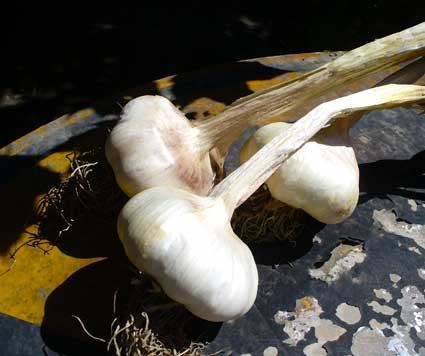
Picture: Lorz Italian Garlic on Metal Drum.
5) Some truly interesting and occasionally very disturbing examples of garlic art on sale at Etsy.
Patty has taken many of the beautiful photographs we use on the web and our brochures. Since she has gone back to college I have taken over most of the photos. The hardest part is sneaking up on the shy garlic growers to get those elusive action photos. Sadly often they try to escape or direct my attention to the youngest and cutest members of the garlic growing tribe (who luckily love posing for photos).
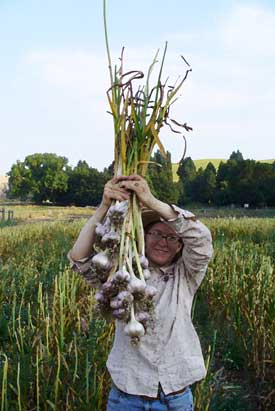 Picture: The Joy of Harvest! Patty holds a freshly harvested bunch of Siberian garlic bulbs above her head.
Picture: The Joy of Harvest! Patty holds a freshly harvested bunch of Siberian garlic bulbs above her head.
Of course, there is a limit to the number of different ways you can portray some aspects of garlic growing and still make it 'fresh' and exciting. With garlic weeding that limit may be one. We've thought of ways to make garlic farming 'sexy' but decided that they weren't suitable for a family friendly website (as well as being potentially itchy for the models).
In addition to doing the artwork, I research and write the articles for the website with loads of creative input from Jane on what garlic growers want to learn about. Sometimes the creative input consists of 'why do we need over 100 pages on our website?'
We hope that you enjoy browsing through our art in our website!
References:
- Bonaduce I, Colombini MP, Diring S. Identification of garlic in old gildings by gas chromatography-mass spectrometry. Journal of Chromatography. 2006;1107:226-32. doi: 10.1016/j.chroma.2005.12.053
